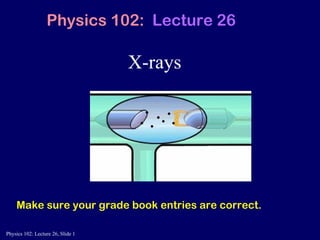
Lect26 handout
- 1. X-rays Physics 102: Lecture 26 Make sure your grade book entries are correct.
- 2. X-Rays Photons with energy in approx range 100eV to 100,000eV . This large energy means they go right through you (except for your bones). What are the wavelengths? .01 nm to 10 nm
- 7. Bremsstrahlung Practice Electron loses ALL of its energy in one collision and emits one photon. Example Minimum wavelength Maximum energy An electron is accelerated through 50,000 volts What is the minimum wavelength photon it can produce when striking a target? intensity 0
- 8. Characteristic x-ray nomenclature n=1 “K shell” n=2 “L shell” n=3 “M shell” Characteristic X-Rays Electron knocks one of the two K shell (ground state) electrons out of an atom. L (n=2) or higher shell electron falls down to K shell (ground state) and x-ray photon is emitted e - e - e - e - e - K shell (n=1) L shell (n=2) e - ejected electron e - e -
- 9. Characteristic x-ray nomenclature n=1 “K shell” n=2 “L shell” n=3 “M shell” Characteristic X-Rays Electron knocks one of the two K shell (ground state) electrons out of an atom. L (n=2) or higher shell electron falls down to K shell (ground state) and x-ray photon is emitted e - e - e - e - e - K shell (n=1) L shell (n=2) X-Ray photon emitted L shell electron falls down e - e - “ K X-ray” (n=2 n=1 transition)
- 10. K X-Rays Estimate the energy of K X-rays off of a silver (Ag) target (Z=47). Not bad! Example L K n=2 n=1 photon (vs. Expt) intensity K Better formula for multi-electron atoms
- 11. K X-Rays Not as likely, but possible. Produces K X-Rays! Different elements have different Characteristic X-Rays K X-rays come from n=2 n=1 transition. What about n=3 n=1 transition? K X-Rays are higher energy (lower ) than K (and lower intensity) K K intensity
- 12. All Together Now... Brehmsstrahlung X-Rays and Characteristic X-Rays both occur at the same time. 0 intensity K K intensity K K intensity 0
- 13. Preflight 26.1 These two plots correspond to X-Ray tubes that: (1) Are operating at different voltages (2) Contain different elements (3) Both (4) Neither K K intensity K K
- 14. ACT: X-Rays I Which graph corresponds to the tube being operated at the higher voltage? 1) Top 2) Bottom intensity intensity
- 15. ACT: X-Rays II The top spectrum comes from a tube with a silver target (Ag, Z=47). What is the bottom target? 1) Pd, Z=46 2) Ag, Z=47 3) Cd, Z=48 intensity intensity
- 16. From atoms to nuclei to nucleons to quarks: The hierarchy of sizes
- 17. Nuclear Physics Nucleus = Protons+ Neutrons nucleons A = nucleon number (atomic mass number) Gives you mass density of element Z = proton number (atomic number) Gives chemical properties (and name) N = neutron number A=N+Z A Z
- 19. Strong Nuclear Force Hydrogen atom: Binding energy =13.6eV Simplest Nucleus: Deuteron= neutron + proton (Isotope of H) (of electron to nucleus) Binding energy of deuteron = or 2.2Mev! That’s around 200,000 times bigger! neutron proton Very strong force Coulomb force electron proton
- 20. Smaller is Bigger! Comparing Nuclear and Atomic sizes Nucleus is 10 4 times smaller and binding energy is 10 5 times larger! Hydrogen Atom: Bohr radius = Nucleus with nucl number A: Note the TREMENDOUS difference has radius Example A Z
- 21. Nuclei have energy level (just like atoms) 12 C energy levels Note the energy scale is MeV rather than eV energy needed to remove a proton from 12 C is 16.0 MeV energy needed to remove a neutron from 12 C is 18.7 MeV
Notas del editor
- E=13.6Z^2/n^2
- Students should sketch graph.
- Rutherford experiment: positive charge contained in tiny nucleus Size of nucleus = few fm Size of H atom = 0.05 nm = 50 fm What keeps protons together?